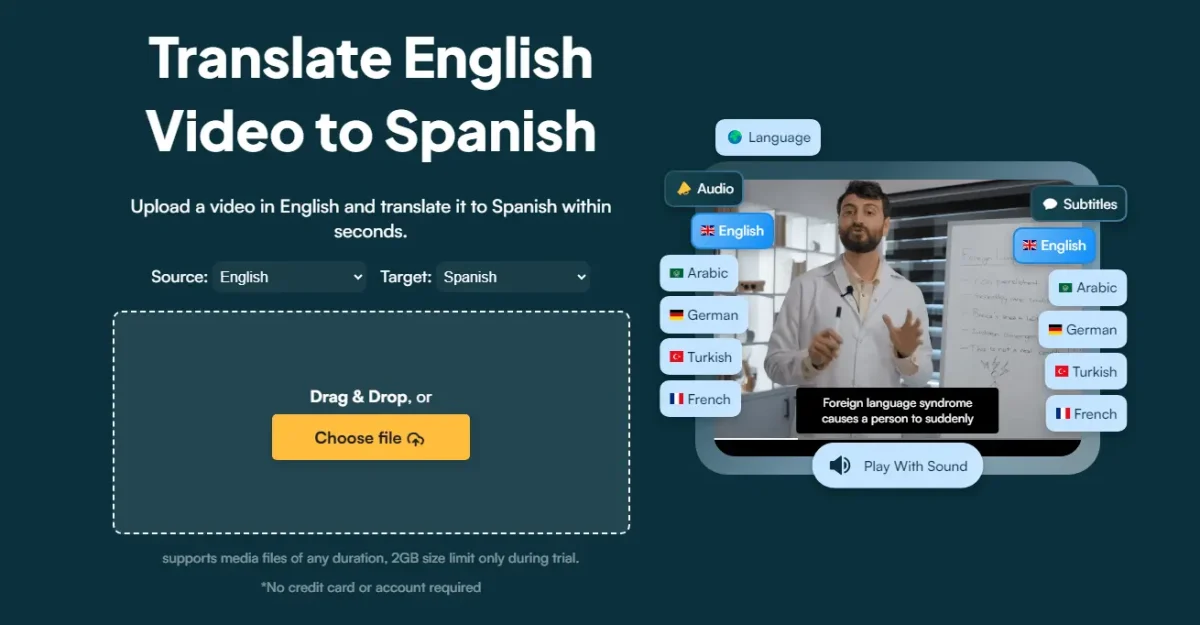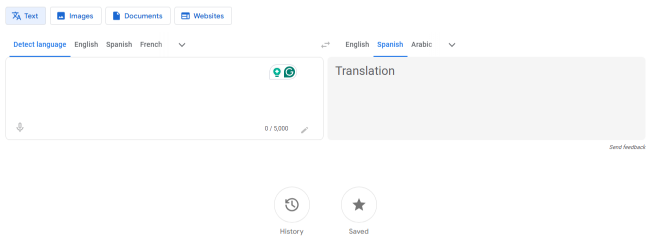6 Best Spanish Translator Apps for Every Use Case

Whether you are a native Spanish speaker or someone new to the Spanish language, you might need a translator app. Luckily, there are a great number of options that can help you break language barriers.
If you are learning a new language, traveling abroad, or dealing with international business tasks, an app that can translate from Spanish to another language or vice versa is a great asset for you. But, how can you find the best one out of the countless options? In this blog post, we've gathered 6 tools on a list for you to choose the best Spanish Translator app according to your needs.
Top Spanish Translator Apps Comparison
If you are on the lookout for the best Spanish translator, this list has you covered. These five apps offer various solutions that help you communicate fluently and stress-free. Let's get started!
| Tool | Pricing | Key Features | Use Cases |
|---|---|---|---|
| Maestra.ai | Starting from $10 | Transcription, subtitle creation, audio dubbing, and voice cloning | Content-related workers, individuals or teams |
| iTranslate | Free &
In-app purchases |
Voice translation and offline mode | Travelers and casual users |
| SpanishDictionary.com | Free &
$12.99/mo |
Educational tools | Students, educators, Spanish learners |
| DeepL | Free &
paid plans starting from $8.74/mo to $57.49 |
Document translation and formality control | Businesses, professional translators, academic users |
| Reverso | Free &
paid plans starting from $9.99 to $35.99 |
Contextual translations, real-world usage examples, and offline mode | Learners, travelers, and professionals needing an understanding of the context |
| Google Translate | Free | Text, voice, and image translation, offline mode, and conversation mode | Travelers and casual users |
6 Best Spanish Translator Apps in Detail
Let's dive deep into each of these tools to take a look at their pros, cons, and important aspects.
1. Maestra.ai
Maestra.ai is the best Spanish translator app for you if your focus is audio and video content. You can upload a recording or a video in Spanish and translate it to 125+ languages using AI dubbing and/or subtitles, making it ideal for multilingual content creators.

To translate a video to Spanish, you don't have to upload a file. You can paste the URL of a video into Maestra's free AI video translator.

Maestra offers AI voices that can be used in various languages for dubbing and voiceovers, and its subtitle translator generates and translates subtitles within just a few seconds.
Pros:
- High-quality audio and video content
- Supports multiple languages
- Can replicate your voice in Spanish
- Provides transcriptions and subtitles in Spanish too
Cons:
- Focused on media translation
- Doesn't provide language learning materials like some tools do
Turn Spanish Videos Into Global Interactions!
2. iTranslate
iTranslate is an IOS and Android app that you can download for free. You can also access iTranslator via their website. You can use it for text and voice translations. If you are using the app, you can also use your camera to translate.

iTranslate supports 100+ languages, and you can use it offline for 41 languages. There is a keyboard extension enabling you to write text messages and send them in different languages without needing to change applications.

Pros:
- Provides real-time support for casual conversations
- Makes texting in multiple languages easier with the keyboard extension
- Can be used offline for Spanish
Cons:
- Limited free use
- Can struggle with capturing fast or accented speech
- Pronunciation accuracy might change depending on different Spanish dialects
3. SpanishDictionary.com
As the name suggests, SpanishDictionary.com focuses exclusively on Spanish. You can use it via its website or download its app. With the free version, you can only translate texts. The premium version allows you to upload documents and do voice translations.

SpanishDictionary.com provides translations only between Spanish and English and offers additional features for Spanish learners. There are grammar lessons, verb conjugations, vocabulary studies, and pronunciation lessons. So, if you are trying to learn Spanish and need a translator, this might be the best Spanish translator app for you.

Pros:
- Specializes in Spanish-English translations
- Provides educational materials to help language acquisition
- Introduces cultural expressions in Spanish to users
Cons:
- Not useful for language couples other than English and Spanish
- Features like voice input, document translations, and vocabulary lessons require a paid subscription
- Doesn't provide image translations
4. DeepL
DeepL translator is available as a website, an extension, and a downloadable application. It supports 30+ languages.
There is a free version of DeepL, but it has limitations. If you are a casual user, you might still benefit from the free version, but you will need a paid subscription to manage your monthly projects and have access to advanced features. A free trial is available for 30 days.

You can upload documents to translate them. You can use the edit mode to refine your Spanish translations, and you can rewrite translations using the preset writing styles to adjust their tone. This helps businesses appeal to the right audience.

Pros:
- High accuracy
- Provides alternative translations to choose the best among them
- Works well with formal texts
Cons:
- Cannot be used offline
- Limited language support compared to other tools
- Monthly character limitations on the free version
5. Google Translate
There is no doubt that Google Translate is the most popular translation app worldwide. You can access this translator via their website, Chrome extension, and application for mobile and desktop devices. It is free, and it supports over 200 languages. So, almost everyone can translate both from Spanish and into Spanish.

Google Translate supports various translation options. For your Spanish translations, you can type in or dictate, upload an image or a document, and paste a website's URL into Google Translate. If you are using the mobile app, you can point your camera at what you want to translate.
Google Translate provides downloadable language packages so that you can translate them offline. It also allows you to save your translations to review them later.

Pros:
- Supports various languages
- Supports regional variations of Spanish
- Conversation mode
- Can be used offline
Cons:
- Can have difficulties with idiomatic expressions
- Translations might be too literal
- Doesn't provide educational content to support language acquisition
6. Reverso
Reverso is another app that has a free version. There is also a bundle called Reverso Premium. Reverso focuses on context more than most of its competitors. It supports 25+ languages, and you can download language packages to use Reverso offline.

You can upload documents in various formats to translate them. Reverso does not only provide translation services but also provides an automatic spell-checker for your original texts. You can also benefit from Reverso's synonyms and verb conjugation features if you are learning Spanish.

Pros:
- Provides translations based on context
- Works well with idiomatic phrases in Spanish
- Provides educational tools for language learners
Cons:
- Limited language support compared to other tools
- Limited voice translation options
Choosing the Best Spanish Translator App for You
Today's digital landscape makes it possible to translate from one language to another with so many applications. But some tools are more convenient than others. If you have a specific goal in mind, such as learning Spanish, traveling to a Spanish-speaking country, or creating multiple-language content, you need to take that into consideration to choose the best tool for you.

What to Look For in a Translation App
In order to make an educated choice, you need to do an extensive research. Then you can decide which tool will address your needs better. Let's review key things to consider:
- If you are a student or someone learning Spanish, you will benefit from tools like Spanishdictionary.com and Reverso that offer educational content.
- If you need a translation app for your travels, you can benefit from tools like iTranslate and Google Translate that provide real-time translation services.
- If you need to translate formal texts, DeepL can help you with them. But, if you need something more than simple text translations, you should go for Maestra. Maestra.ai caters to specific user groups with its audio and video content, subtitles, and transcriptions.
An All-in-One Soluton for Video Translation
Frequently Asked Questions
What is the most accurate Spanish translation app?
When it comes to accuracy in translations, there are three types of apps:
- The ones focusing on contextual translations provide high accuracy because they focus on context and what words can mean beneath the surface.
- The ones specializing in language teaching provide high accuracy because they too consider context, and they deal with many aspects of languages.
- AI-powered tools provide great accuracy because they analyze the whole text without just focusing on individual words. They always continue learning, and they can adapt to new language trends easily.
Is there a better Spanish translator than Google?
Google Translate can be great for travelers and casual users needing real-time translation. But, if you are a content creator who needs to reach a global audience or a student who just started to learn Spanish, there are better tools like Maestra AI.
Is Google Translate 100% right?
No, Google Translate is not 100% accurate. While it can provide high accuracy, there are many factors affecting its accuracy. For example, when dealing with formal documents, idiomatic phrases, or complex sentences, its accuracy might drop.
